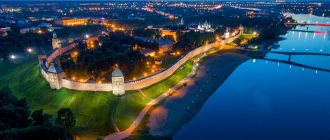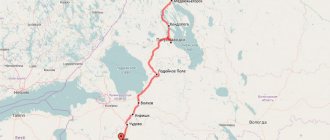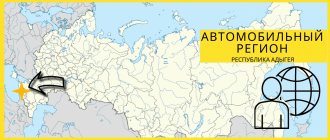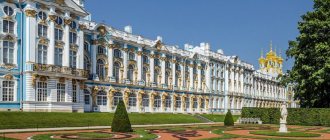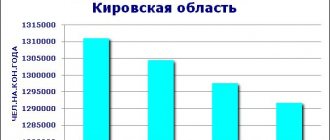Siberian Federal District
Date of formation: May 13, 2000. The Siberian Federal District includes 12 subjects of the Russian Federation (since January 1, 2007, the Taimyr (Dolgano-Nenets) Autonomous Okrug and the Evenki Autonomous Okrug are part of the united Krasnoyarsk Territory. Since January 1, 2008, the Ust-Ordynsky Buryat Autonomous Okrug is part of the united Irkutsk Region. On March 1, 2008, as a result of the merger of the Chita region and the Aginsky Buryat Autonomous Okrug, the Trans-Baikal Territory was formed).
The territory of the Siberian Federal District makes up 30% of the territory of Russia, the population is 20.06 million people. The following are concentrated in Siberia: 85% of all-Russian reserves of lead and platinum, 80% of coal and molybdenum, 71% of nickel, 69% of copper, 44% of silver, 40% of gold. The gross regional product is 11.4% of Russia's GDP. The district's share in the total industrial production of the Russian Federation in 2001 was 12.4%. The share of the Siberian Federal District in the total length of Russian railways is 17.5%.
general characteristics
Date of formation : May 13, 2000.
Composition of the Siberian Federal District
12 constituent entities of the Russian Federation, including:
- 4 republics (Altai, Buryatia, Tyva, Khakassia);
- 3 regions (Altai, Transbaikal, Krasnoyarsk);
- 5 regions (Irkutsk, Kemerovo, Novosibirsk, Omsk, Tomsk).
Administrative center - Novosibirsk
Administrative division
A total of 4190 municipalities, of which:
- municipal districts - 320,
- urban districts - 79,
- urban settlements - 261,
- rural settlements - 3530.
Territory
total area
- 5114.8 thousand km2 (30% of the territory of Russia).
Length of territory
- north to south – 3566 km;
- from west to east – 3420 km.
The county borders
- in the north - with the Yamalo-Nenets Autonomous Okrug, which is part of the Tyumen region;
- in the west - with the Tyumen region, the Yamalo-Nenets Autonomous Okrug, the Khanty-Mansiysk Autonomous Okrug;
- in the east - with the Republic of Sakha (Yakutia), Amur region;
- in the south - with the Republic of Kazakhstan, the Republic of Mongolia, and the People's Republic of China.
Length of the state border
- 7269.6 km,
including:
- with the Republic of Kazakhstan - 2697.9 km;
- with the Republic of Mongolia - 3316.2 km;
- with the People's Republic of China - 1255.5 km.
Characteristics of the state border
- border outposts – 120;
- border checkpoints – 63;
- customs posts – 71.
Population
(Here and below are the data from the 2002 All-Russian Population Census)
Population – 20,062.9 thousand people.
Population density – 3.9 people. per 1 km2.
The share of the urban population is 71.1%, rural – 28.9%.
National composition
- Russians - 87.38%
- Buryats - 2.13%
- Ukrainians - 1.86%
- Germans - 1.54%
- Tatars - 1.26%
- Tuvans - 1.20%
- Kazakhs - 0.62%
- Belarusians - 0.41%
- Khakass - 0.36%
- Altaians - 0.33%
- Chuvash - 0.31%
- Azerbaijanis - 0.30%
- Armenians - 0.30%
Natural resources
Mineral resources
The following are concentrated in Siberia:
- 85% of all-Russian reserves of lead and platinum;
- 80% coal and molybdenum;
- 71% nickel;
- 69% copper;
- 44% silver;
- 40% gold.
Land resources:
- 59.0% of land under forests;
- 8.1% - swamps;
- 11.1% - agricultural land;
- 3.3% - water bodies;
- 18.5% - other lands.
Of all the lands under reindeer pastures – 11.0%.
Forest resources
The total area of the forest fund is 371,899 thousand hectares;
- including the area occupied by coniferous species - 190,268 thousand hectares.
The total standing timber stock is 33,346 million m3.
Specially protected natural sites
On the territory of the district there are:
- 21 state nature reserves (42.3% of the area of Russian reserves);
- 6 national parks (35.9% of the area of Russian national parks).
Hunting grounds
The area of the district's hunting grounds is 30.7% of the total area of hunting grounds in Russia.
Economy
The leading sector of the economy of the Siberian Federal District is industry.
Gross regional product – 715.2 billion rubles. (or 11.4% of GRP in Russia).
Gross regional product per capita – 34.5 thousand rubles. (in Russia – 43.3 thousand rubles).
Industry
The district's share in the total industrial production of the Russian Federation in 2001 was 12.4%.
Leading industries:
- non-ferrous metallurgy;
- electric power industry;
- forestry and woodworking;
- ferrous metallurgy;
- chemical and petrochemical;
- food and flour milling;
- fuel;
- building materials;
- mechanical engineering and metalworking;
- light.
Agriculture
The district's share in the total volume of agricultural production in Russia in 2001 was 16.2%.
The most important branches of agriculture: livestock breeding, grain production, vegetable growing.
The volume of agricultural production in 2001 was 161,875 million rubles, including products:
- crop production – 83933 million rubles;
- livestock farming – 77942 million rubles.
Foreign trade activities
Foreign trade turnover in 2006: (according to customs statistics)
- 36984.5 million US dollars (including the volume of exports - 31949 million dollars; imports - 5035.5 million dollars).
The Siberian Federal District is the main transport hub of Russia
The unique geopolitical position of Siberia (together with the Far East) as a bridge between Europe and Asia.
The main transit flows of Russia (freight and passenger transportation) from the European part of the country to the Asian part pass through the Siberian Federal District.
Share of the Siberian Federal District in the total length:
- Russian railways – 17.5% (2nd place);
- highways (general and departmental use) in Russia – 16.8% (3rd place);
- navigable inland waterways of Russia – 29.7% (1st place).
The territory is attractive for international cooperation
On the territory of the district there are representative offices of 7 foreign countries:
- Federal Republic of Germany (Novosibirsk - Consulate General of the Federal Republic of Germany);
- Mongolia (Irkutsk, Kyzyl (Republic of Tyva), Ulan-Ude (Republic of Buryatia) - Consulates General of Mongolia);
- Poland (Irkutsk - Consulate General of Poland);
- Israel (Novosibirsk - Israeli Cultural and Information Center);
- Italy (Novosibirsk - department of the department for the development of trade exchanges of the Italian Embassy);
- Republic of Belarus (Novosibirsk - branch of the Embassy of the Republic of Belarus);
- Bulgaria (Novosibirsk - Consulate General of Bulgaria).
The Siberian Federal District includes territories with extreme living conditions
to the regions of the Far North and equivalent areas:
Republic of Tyva, Taimyr (Dolgano-Nenets) municipal district, Evenki municipal district; partly the territory of 6 subjects - the Republic of Buryatia, the Altai Republic, the Krasnoyarsk Territory, the Trans-Baikal Territory, the Irkutsk, Tomsk regions. About 70 thousand people live in the district. 18 nationalities of indigenous peoples of the North and Siberia (more than one third of the 45 indigenous peoples of the North and Siberia living in the Russian Federation).
Social complex
The science
On the territory of the district there are Siberian branches of 3 Russian Academies of Sciences - SB RAS (Siberian Branch of the Russian Academy of Sciences), SB RAAS (Siberian Branch of the Russian Academy of Agricultural Sciences), SB RAMS (Siberian Branch of the Russian Academy of Medical Sciences), which includes more than 100 research organizations, as well as a network of research and experimental stations.
Education
- The number of daytime educational institutions is 11,168 (including 77 non-state ones);
- The number of state secondary specialized educational institutions is 401;
- The number of higher educational institutions is 110 (including 28 non-state ones).
The largest number of universities is concentrated in the Novosibirsk (24), Omsk (18) regions, Krasnoyarsk Territory (15), Irkutsk (14), Kemerovo (10) and Tomsk (8) regions. The total number of students in various types of educational institutions in the district is 4045.0 thousand people. (14.8% of the total number of students in Russia),
including:
- in daytime educational institutions - 2919.9 thousand people. (15.0% of students in Russian schools);
- in secondary specialized educational institutions - 369.8 thousand people. (15.3% of the number of Russian secondary school students);
- in universities - 755.3 thousand people. (13.9% of the number of Russian university students).
Healthcare
Number:
- hospital institutions – 1847;
- hospital beds - 234.6 thousand units;
- medical outpatient clinics - 3644 with a capacity of 507.6 thousand visits per shift;
- doctors of all specialties - 96.3 thousand people;
- nursing staff - 218.1 thousand people.
In terms of the number of doctors per 10 thousand population (46.5), the district ranks 4th, and the number of nursing staff per 10 thousand population (105.5) is 6th in Russia.
Culture
- the number of theater spectators per 1000 population is 205 (3rd place in Russia);
- number of museum visits per 1000 population – 342 (3rd place in Russia);
- library collection of public libraries per 1000 population, copies – 6465 (5th place in Russia);
- newspaper production per 1000 population (single circulation, copies) – 283 (7th place in Russia).
Physical education and sports
Number of sports facilities – 23557;
including:
- stadiums with stands for 1,500 or more seats – 375 (3rd place in Russia);
- flat sports structures (grounds and fields) – 14469 (4th place in Russia);
- gyms – 8323 (3rd place in Russia);
- swimming pools – 390 (3rd place in Russia).
